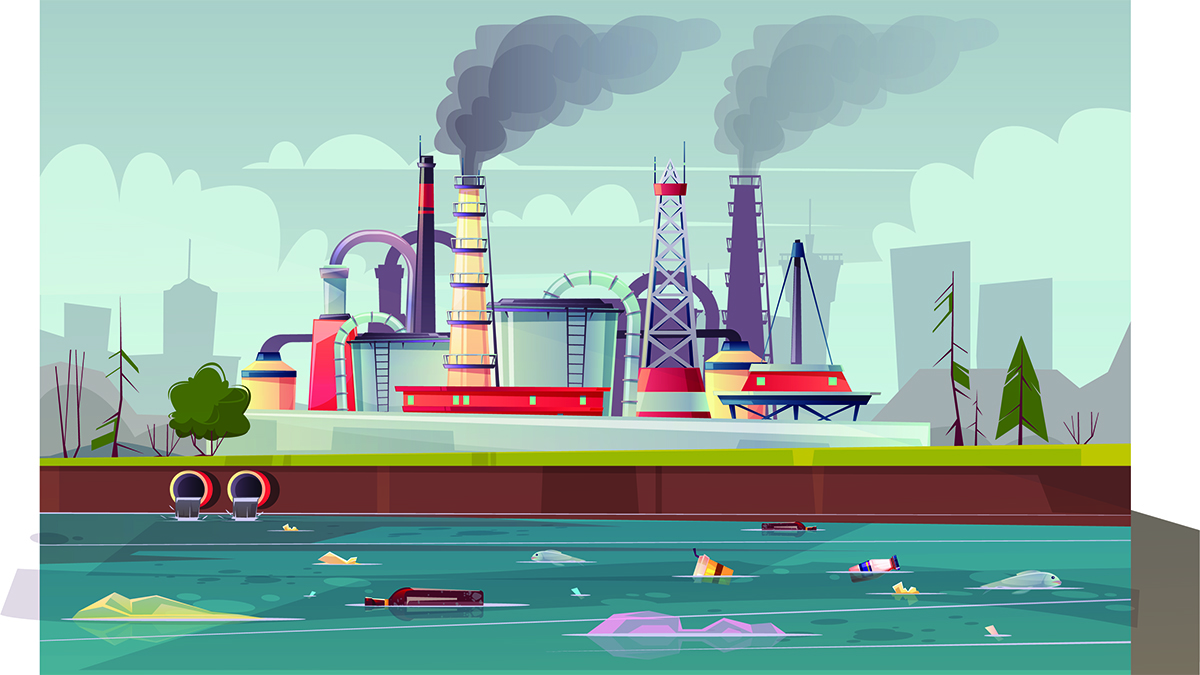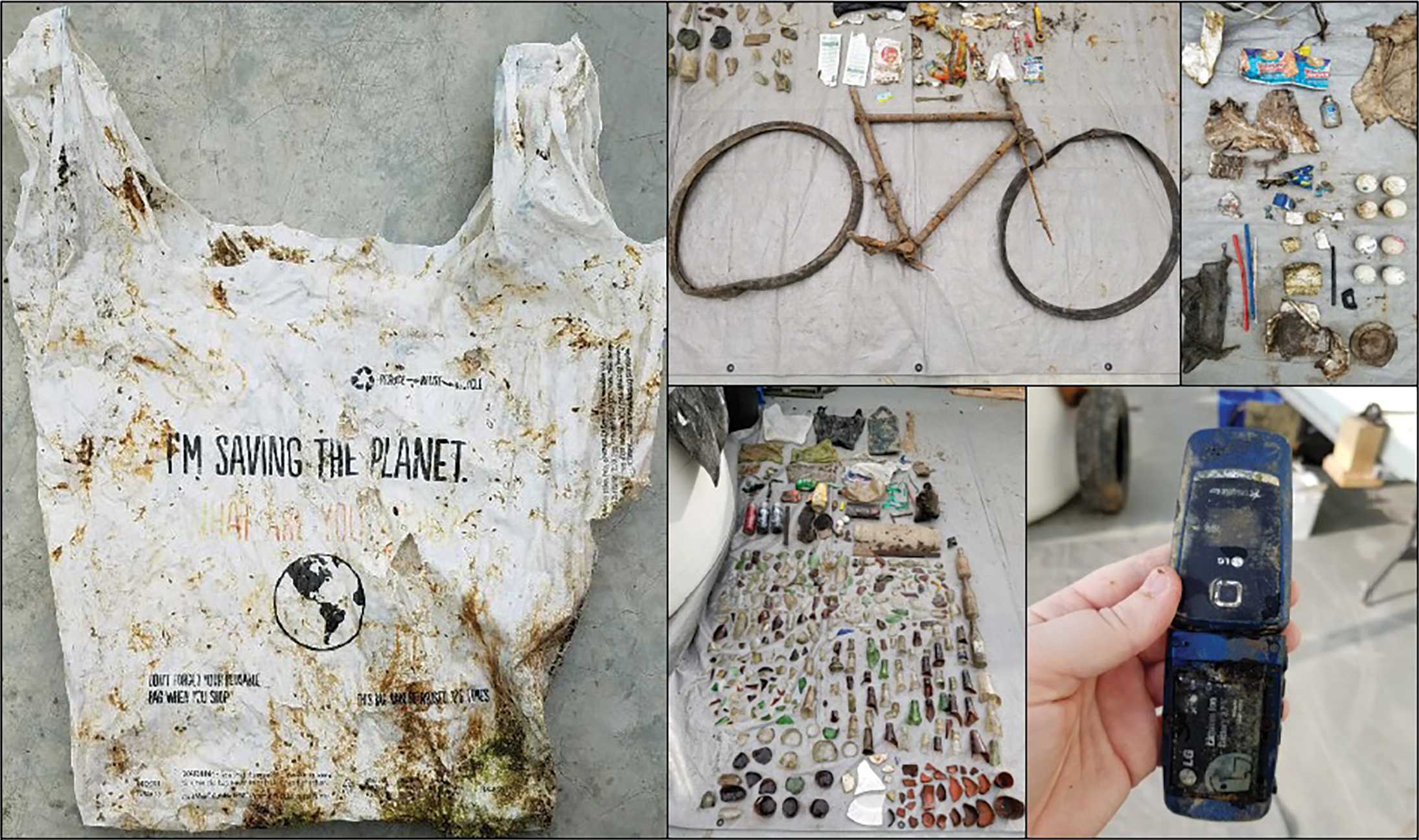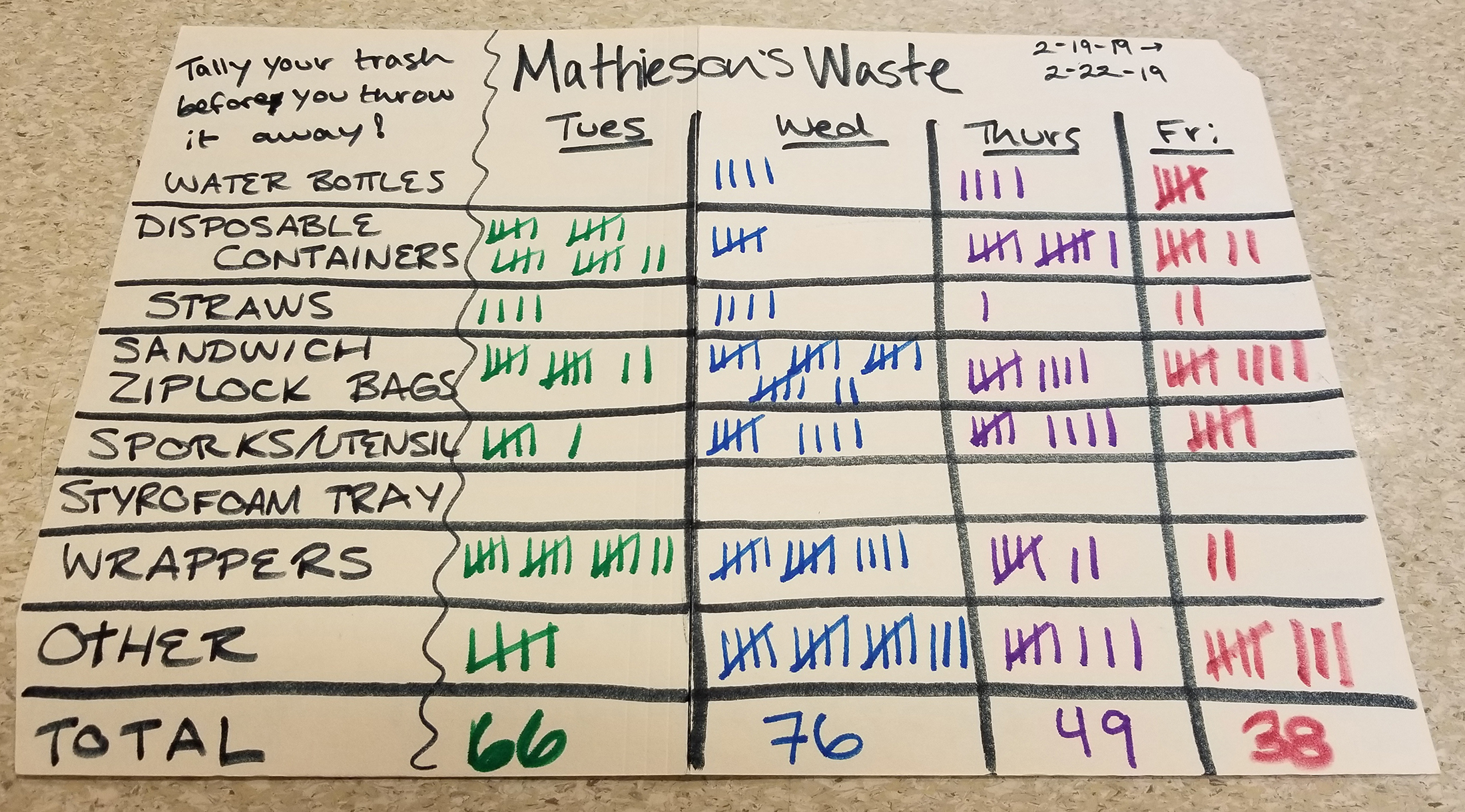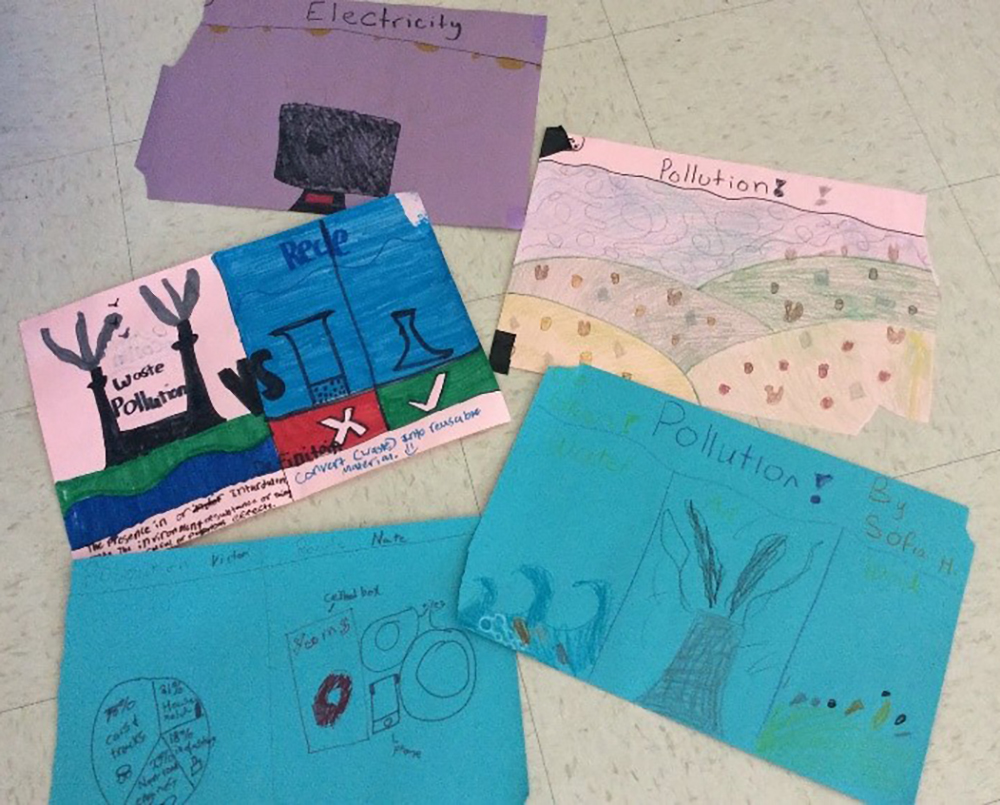Feature
Talking Trash
A Human Problem with Human Solutions
Science and Children—April/May 2020 (Volume 57, Issue 8)
By Lauren Wisbrock, Erin Reynolds, Jen Mertins, Anne Schultz, Timothy Hoellein, and Lara Smetana

Human-made pollution is a large and complex problem that has harmful effects on communities and ecosystems. Understanding these impacts is essential, but it can be daunting when many types of chemical pollution are difficult to conceptualize, especially for elementary school students. Something every student can understand, however, is trash. Students have seen plastic, glass, paper, and metal litter items along roadsides, falling out of trash cans, and in rivers. There is also a growing social awareness of this litter worldwide. Slogans like “Reduce your Use” and bans and taxes on single-use plastic items are becoming more common. These actions have followed research and stark imagery of animals eating or becoming entangled in trash. Since trash is a concrete example of pollution, something that students can easily see and relate to, it is an excellent starting point to learn about pollution of any kind.
In this article, we present an inquiry unit for fourth- and fifth-grade classrooms designed to build students’ understanding of trash pollution, discover its environmental effects, and communicate how people in their community can reduce those effects. It was created as a collaboration between a team of fourth-grade teachers and an ecology research laboratory at a local university. This series of lessons was designed to integrate the use of articles, websites, data charts, and videos into a framework for students to develop scientific research and communication skills, using trash pollution as the anchoring theme. The unit culminates in students using their research to create a public service announcement to report pollution findings and possible solutions that could be shared with other students and the community.
Grounding in Reality
It was important that conversations from this unit would continue outside of class. Before the unit began, students received a letter to bring home (see NSTA Connection). Most elementary school students don’t have autonomy in what their families buy, use, and throw away, and encouraging discussion might allow them to suggest solutions for reducing waste at home.
On the first day, a graduate student from a local university came to share her research on trash pollution in the Chicago River. Speaking to each of the four classes individually, she brought in actual trash, including plastic candy wrappers, shopping bags, old cell phones, and rusted bike frames, all of which she collected during her research (Figure 1). She handled her trash with gloves, carrying it around the room so students could observe it up close without touching it. Students expressed surprise, excitement, and disgust at the trash. They asked questions like: “How are animals impacted by pollution?” “What can we do to stop pollution?” “What are some examples of pollution?” and “Does composting help eliminate pollution?” which they organized using a KWL (see NSTA Connection for a blank form). The graduate student encouraged classes to research answers to their questions.

Trash collection.
Starting with an expert allowed students to become emotionally invested. They saw that professionals were focused on the same questions they were trying to answer, making their exploration authentic. Other experts that could be invited into the classroom include employees of local municipal waste collection or recycling agencies, local forest preserve managers, or non-profits that run roadside, park, or beach cleanups.
High-Impact Activities
Next, students needed to understand how their small actions can add up quickly when it comes to reducing trash. Every day for one week, students tallied each trash item they produced at lunch before throwing it away and recorded it on their class poster (Figure 2). The categories of bottles, disposable containers, straws, sandwich bags, utensils, foam, wrappers, and “other” were used because they are common in student lunches or are offered in the lunchroom.

Class trash log.
At the end of the week, each class talked about their results in a class discussion. For example, 252 pieces of trash were recorded from just one class of 25 students during a four-day collection period. On the board, students multiplied 252 times the four fourth-grade classes, meaning in one week the fourth grade produced over 1,000 pieces of trash! Next, they multiplied this by the number of grades in the school to get over 6,000 pieces of trash produced only at lunch in just four days. After realizing how much trash they produced during lunch, students brainstormed alternatives to reduce their own waste. Their solutions included: “Bring reusable bottles instead of buying a plastic one,” “Bring metal forks and spoons to school instead of using the plastic utensils.” Many students began to take action by not using the straws made available to them in the lunchroom. One student already brought their lunch with reusable containers and utensils. Classmates were encouraging and cheered them for not adding any trash to their classes’ total tally. This practice allowed the students to realize even though it might seem like their choices alone are small, together we do have a large impact.
Next, we modified a lesson made by the National Oceanic and Atmospheric Administration (NOAA; see Internet Resources) about the water cycle to reflect where all this trash might go once it was thrown away. For this activity, students imagined that they were an individual piece of trash. Stations around the classroom represented places were trash might end up: school, recycling center, ground, river, fish, person, landfill, picked up, ocean, and compost (see NSTA Connection for activity resources). Students’ journeys began at the school, and they rolled dice to determine where they would be brought next. Students had an emotional reaction to this activity, often feeling frustrated when they got stuck in just one location, like in a landfill where their chance of moving to a new location was small. Students recorded their route on an illustration sheet (see NSTA Connection) and reflected on the activity by meeting with different partners to compare their routes and answer reflection questions.
Support and Language Development
After completing the high-impact activities, students needed to spend time learning and practicing new vocabulary words. Words like pollution, dispose, recycle, and compost mean different things to different groups of people and have a variety of connotations. Students have varying levels of familiarity with these words and all students, especially English learners, can benefit from vocabulary support activities (Lee et al. 2012). After watching a series of videos about pollution and its sources (see NSTA Connection), each class created a list of words from those videos they couldn’t define or didn’t understand. Each student picked one word from that list and created a poster with the definition and a picture (Figure 3). These were posted on the wall for students to use as a resource throughout the research process.

Vocabulary posters.
Inquiry Practices
Since this was the first time students had conducted research, our district technology coach gave a lesson on best practices in reading sources. She showed the class a small portion of a photo and asked the students to guess what it was. Then she showed more of the image and students guessed a second time, with more visual information. Then she showed the whole image, letting students see if they were correct (Figure 4). Students reflected on how it is important to notice each detail and not to skim or glance at material. If they do, they could miss important information.

Research/reading activity.
Students were able to choose which focus habitat they would like to study: water, land, or air. Each class had access to 12 Chromebooks and five iPads, and the district technology coaches provided reliable digital resources. If your school does not have the same access to technology, using paper copies of articles found through the links in the Resources below can be just as effective. More important than the use of technology is the students’ ability to determine the significant points in a text, think critically to determine if it relates to their research, and record it in their notes for their project, which can be done regardless of technological context.
Students worked independently to read articles, look at pictures, and watch videos while responding to guided questions using a hyperdoc (see NSTA Connection). A hyperdoc is a digital framework that includes links to resources and allows for independent student learning because of its self-contained prompts (Highfill et al. 2016). Students had never used a hyperdoc before but were quick to understand it because of its easy-to-follow structure. Students were given an entire week of science time (about 45 minutes each day) to complete their hyperdocs. Students who completed the hyperdoc early were asked to reread articles and summarize the information in complete paragraphs, rather than as answers to guided questions. Alternatively, students could be given additional resources to read or watch.
Using their hyperdoc as a reference, students next filled out a written packet with prompts geared toward synthesizing information before writing their public service announcement scripts (see NSTA Connection). They were given two days to answer the five questions and support answers with evidence. During this time, teachers and support staff were working with the students, providing sentence starters and support when needed to help with synthesizing but also checking in on the kids’ progress.
They listed their evidence as bullet points, rather than complete paragraphs, since the goal for this part of the process is to connect ideas together for communication. To support ELL and SPED students, this activity can be modified by having them work in small groups or teacher-led groups rather than independently. Students can also be given sentence stems to clarify the information needed to answer these questions fully.
Once students finished synthesizing their research independently, they were placed in groups with others who had chosen the same focus habitat. Groups were heterogeneous, each with three or four students, but group sizes and composition can be adjusted to fit each class’s needs. Over the course of three days, students went through the five questions in the packet, verbally sharing the bulleted information they had written down. If all group members had written the same piece of information, they highlighted it with a marker to demonstrate that they all thought it was important. Students also added details found by their classmates to their own notes. Many students benefited from sentence starters, including “Land pollution has impacted ________ by__________.” “Water Pollution negatively impacts ecosystems because______________”.
Finally, students got a second copy of the same packet (see NSTA Connection) and, using the information they highlighted, wrote a paragraph for each question. Students were reminded to include details that were meaningful and represented all the knowledge they gained from both their independent research and their group. While this process of students going through the same packet and answering the questions a second time might seem repetitive, it was essential to the inquiry process. Starting with more information and paring it down to what is most important is a necessary research skill, especially before communicating their findings.
Creation of the PSA
The format of a public service announcement (PSA) is a great way for students to summarize and share their research. They are concise and use a combination of facts and emotional appeals to inspire change. After watching a few example PSAs, students were given a rubric outlining the expectations of their PSA that teachers would use for their summative assessment and a “Criteria for Success” sheet, which acted as a formative self-assessment for students to keep track of what task they should be focusing on in a given day (see NSTA Connection).
Students used apps like Touchcast, iMovie, Seesaw, and Clips to create their PSA. Students had varying levels of experience with using these apps, and it was an excellent opportunity for students with more familiarity to take on an expert role and teach their group-mates how to use them. If you do not have technology access, live student presentations are equally effective.
Regardless of the format, students need time to try and fail multiple times during practice (Maltese et al. 2018). Our students practiced their initial draft and timed themselves. In all cases, they were over the 60-second time limit and had to revisit and edit their scripts. They had to decide what was important and what could be cut out. After the edit, they re-timed their PSA to see if they had met the time requirements. In our classes, this took students several attempts over the course of a week of science time. Once groups had recorded short enough scripts, they were invited to use any remaining class time to add special effects, music, and additional creative elements to their final product. If your class is conducting live performances, students could take this time to add props and costumes.
Each group played their PSA for their classmates, providing opportunities for students to share their process, answer questions, and give feedback through a teacher-guided class discussion. It was amazing to see the creativity and personality of each team shine through. Some were more serious in tone, some were silly, but each team proposed solutions for how to reduce trash pollution in their focus habitat and all used a short amount of time to communicate their research in a compelling way. Some solutions included actions that students were already taking, like using reusable food and drink containers and refusing straws. Some were larger, like composting food at home, starting a recycling club at school, or participating in community cleanups. The graduate student came back to view and discuss the presentations. Students loved having her come back to see their hard work. An alternative is to set up several viewing stations on devices with headphones around the room, or to invite students from other classes and grades. This would allow students to create comprehension questions for their own project for other students to answer.
Finally, in their project groups and with their teacher, students reflected on how their overall PSA aligned with the rubric and Criteria for Success. Students even acknowledged ways in which they didn’t meet their own expectations and had room for growth. All students were held to the same expectation of completing the components of the script and PSA, but teachers took into account individual student needs when assessing their depth of knowledge. After they completed this guided self-reflection, the teacher assessed their PSA using the rubric.
Conclusion
Pollution may be a complex, global problem, but through this unit students were able to start to see their relationship to it. They may not be able to discuss the impact of industrial chemicals yet, but they did form an understanding of how humanity’s actions have consequences for the Earth. Trash pollution specifically was a gateway to imagine how to reduce their own environmental impact. Students did this by practicing skills that good citizens use to draw conclusions, including being curious and asking questions, reading from credible sources, and synthesizing the most important information from various credible texts. Students collaborated effectively in small groups to create PSAs that not only demonstrated their understanding of their research but also demonstrated their enthusiasm and unique creativity. In the end, the most important idea students walked away with was that trash pollution is a large problem, but we have the knowledge and resources to be part of the solution.
Acknowledgments
We would like to thank fellow fourth-grade team members Kendra Hurt and Rocky Kleinshmidt for their work in planning and carrying out this unit, and for the student and technology support from Suzanne Weider, Stefanie Cahill, and Kristin Johnson.
Lauren Wisbrock (lreynolds1@luc.edu) is a graduate research assistant at Loyola University in Chicago, Illinois. Erin Reynolds, Jen Mertins, and Anne Schultz are teachers at May Whitney Elementary School in Lake Zurich, Illinois. Timothy Hoellein is an assistant professor, and Lara Smetana is an associate professor, both at Loyola University.
Environmental Science Elementary


